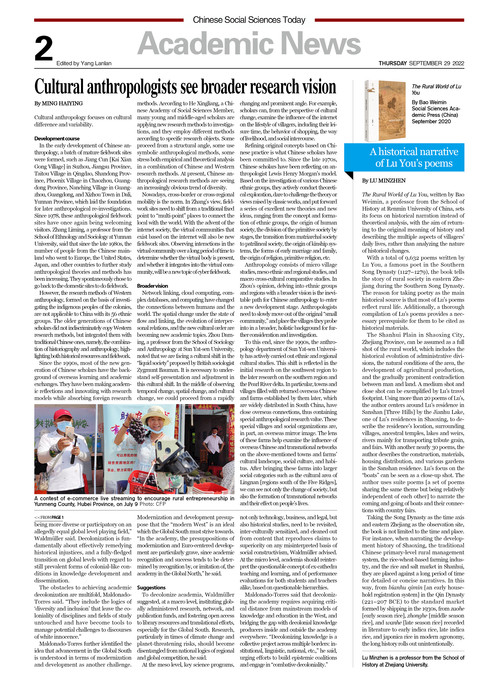Cultural anthropologists see broader research vision
2022-09-29 14:13:22
A contest of e-commerce live streaming to encourage rural entrepreneurship in Yunmeng County, Hubei Province, on July 9 Photo: CFP
By MING HAIYING
Cultural anthropology focuses on cultural difference and variability.
Development course
In the early development of Chinese anthropology, a batch of mature fieldwork sites were formed, such as Jiang Cun [Kai Xian Gong Village] in Suzhou, Jiangsu Province, Taitou Village in Qingdao, Shandong Province, Phoenix Village in Chaozhou, Guangdong Province, Nanching Village in Guangzhou, Guangdong, and Xizhou Town in Dali, Yunnan Province, which laid the foundation for later anthropological re-investigations. Since 1978, these anthropological fieldwork sites have once again being welcoming visitors. Zhang Liming, a professor from the School of Ethnology and Sociology at Yunnan University, said that since the late 1980s, the number of people from the Chinese mainland who went to Europe, the United States, Japan, and other countries to further study anthropological theories and methods has been increasing. They spontaneously chose to go back to the domestic sites to do fieldwork.
However, the research methods of Western anthropology, formed on the basis of investigating the indigenous peoples of the colonies, are not applicable to China with its 56 ethnic groups. The older generations of Chinese scholars did not indiscriminately copy Western research methods, but integrated them with traditional Chinese ones, namely, the combination of historiography and anthropology, highlighting both historical resources and fieldwork.
Since the 1990s, most of the new generation of Chinese scholars have the background of overseas learning and academic exchanges. They have been making academic reflections and innovating with research models while absorbing foreign research methods. According to He Xingliang, a Chinese Academy of Social Sciences Member, many young and middle-aged scholars are applying new research methods to investigations, and they employ different methods according to specific research objects. Some proceed from a structural angle, some use symbolic anthropological methods, some stress both empirical and theoretical analysis in a combination of Chinese and Western research methods. At present, Chinese anthropological research methods are seeing an increasingly obvious trend of diversity.
Nowadays, cross-border or cross-regional mobility is the norm. In Zhang’s view, fieldwork sites need to shift from a traditional fixed point to “multi-point” places to connect the local with the world. With the advent of the internet society, the virtual communities that exist based on the internet will also be new fieldwork sites. Observing interactions in the virtual community over a long period of time to determine whether the virtual body is present, and whether it integrates into the virtual community, will be a new topic of cyber fieldwork.
Broader vision
Network linking, cloud computing, complex databases, and computing have changed the connections between humans and the world. The spatial change under the state of flow and linking, the evolution of interpersonal relations, and the new cultural order are becoming new academic topics. Zhou Daming, a professor from the School of Sociology and Anthropology at Sun Yat-sen University, noted that we are facing a cultural shift in the “liquid society” proposed by British sociologist Zygmunt Bauman. It is necessary to understand self-presentation and adjustment in this cultural shift. In the middle of observing temporal change, spatial change, and cultural change, we could proceed from a rapidly changing and prominent angle. For example, scholars can, from the perspective of cultural change, examine the influence of the internet on the lifestyle of villagers, including their leisure time, the behavior of shopping, the way of livelihood, and social intercourse.
Refining original concepts based on Chinese practice is what Chinese scholars have been committed to. Since the late 1970s, Chinese scholars have been reflecting on anthropologist Lewis Henry Morgan’s model. Based on the investigation of various Chinese ethnic groups, they actively conduct theoretical exploration, dare to challenge the theory or views raised by classic works, and put forward a series of excellent new theories and new ideas, ranging from the concept and formation of ethnic groups, the origin of human society, the division of the primitive society by stages, the transition from matriarchal society to patrilineal society, the origin of kinship systems, the forms of early marriage and family, the origin of religion, primitive religion, etc.
Anthropology consists of micro village studies, meso ethnic and regional studies, and macro cross-cultural comparative studies. In Zhou’s opinion, delving into ethnic groups and regions with a broader vision is the inevitable path for Chinese anthropology to enter a new development stage. Anthropologists need to slowly move out of the original “small community,” and place the villages they probe into in a broader, holistic background for further consideration and investigation.
To this end, since the 1990s, the anthropology department of Sun Yat-sen University has actively carried out ethnic and regional cultural studies. This shift is reflected in the initial research on the southwest region to the later research on the southern region and the Pearl River delta. In particular, towns and villages filled with returned overseas Chinese and farms established by them later, which are widely distributed in South China, have close overseas connections, thus containing special anthropological research value. These special villages and social organizations are, in part, an overseas mirror image. The lens of these farms help examine the influence of overseas Chinese and transnational networks on the above-mentioned towns and farms’ cultural landscape, social culture, and habitus. After bringing these farms into larger social categories such as the cultural area of Lingnan [regions south of the Five Ridges], we can see not only the change of society, but also the formation of transnational networks and their effect on people’s lives.



